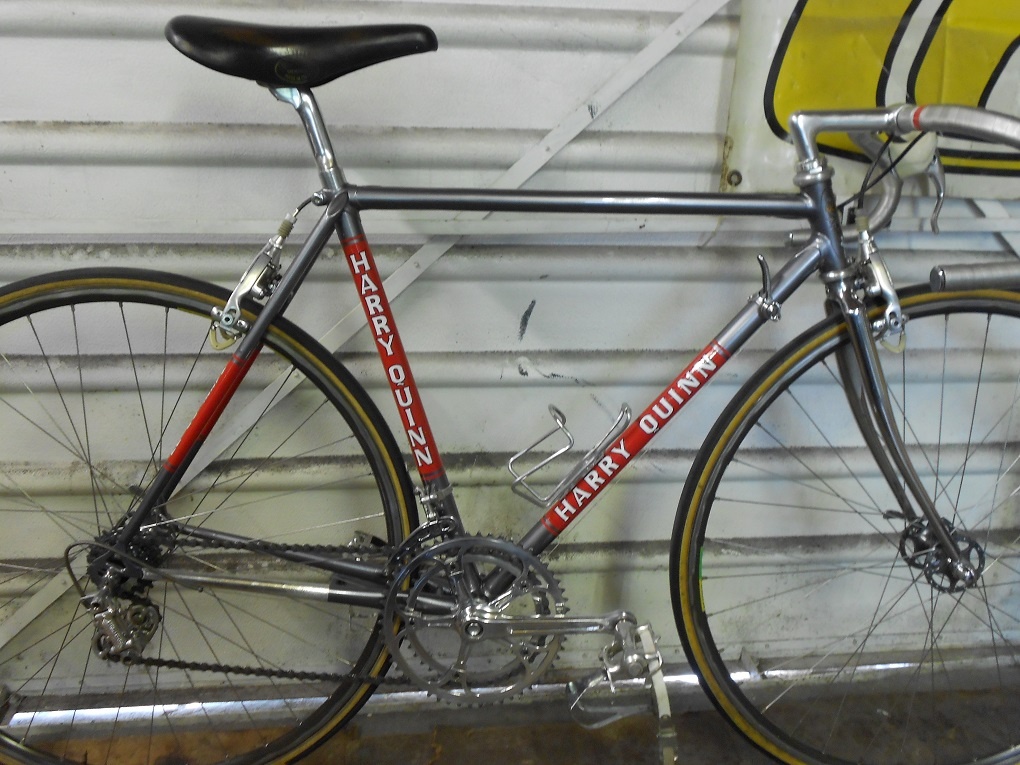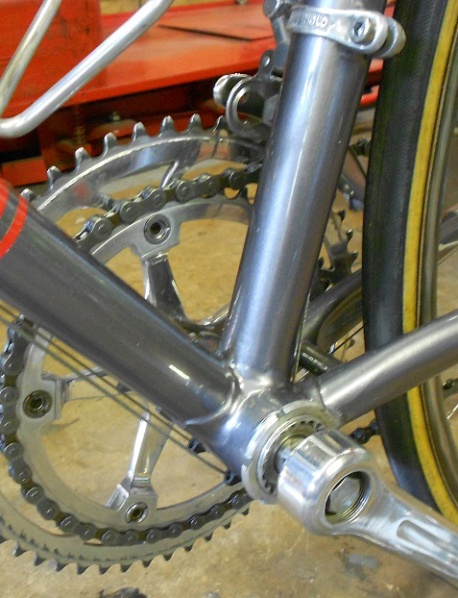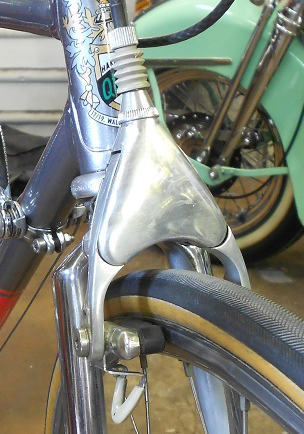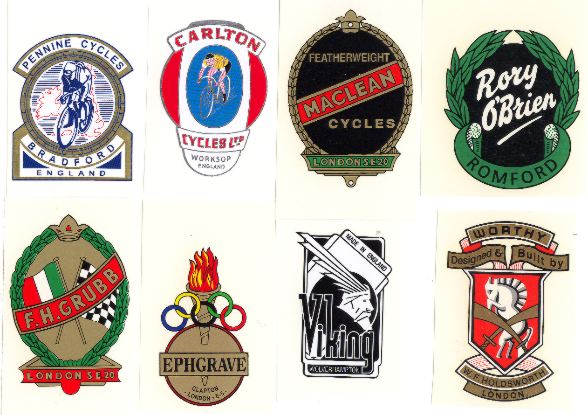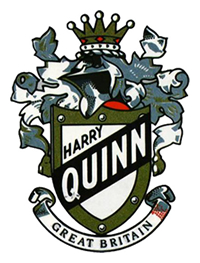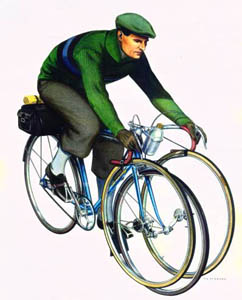Vol. 2, Issue 58 - July / August 2015
Posted: Saturday 15th August 2020
Just before the last edition was published we were able to ride in the 2015 London Tweed Run which started in Trafalgar Square this year. As usual there was a magnificent turnout of folk dressed rather nattily in Tweed. I always think there are two approaches to the ride: there are some who really pull out all the stops as far as dress goes but may ride a rather mundane cycle. We belong to a minority group who value the bicycle first and complement it with a reasonably tweedy outfit.
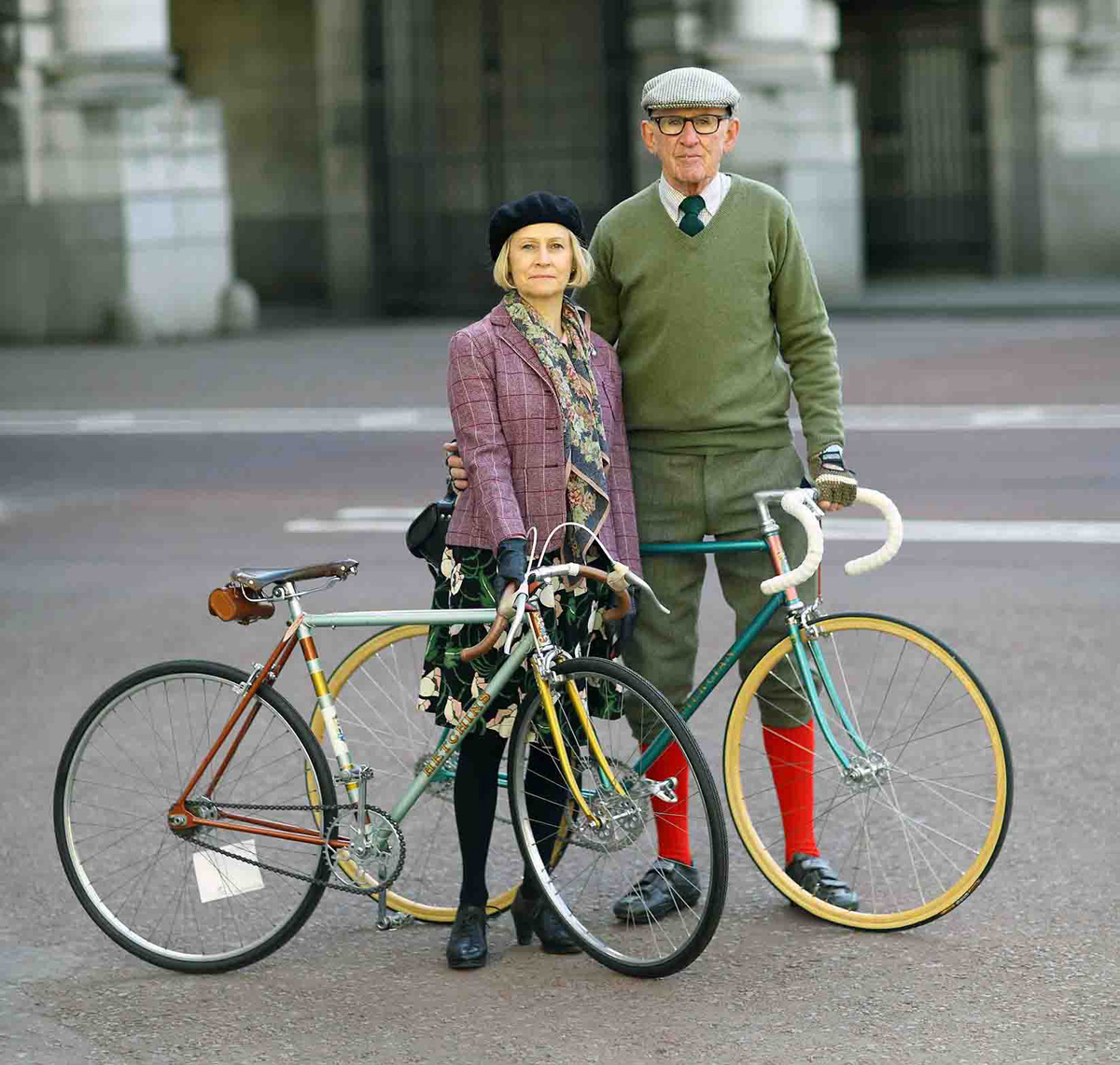
Although we had a lot of photographs taken on the day many were by overseas photographers but the one above was taken by our photographer friend Horst Friedrichs who produced the popular book of photographs entitled Cycle Style as well as others covering motor cyclists, scooter riders and drivers of classic cars. It was taken at the top of The Mall by the Admiralty Arch.
I rode my Mercian Vigorelli track with cane sprints while Patricia took her Hetchins Swallow track, which always attracts a lot of attention with its very striking and original paint job.
This year the marshalling was done a different way with the groups sent off in waves of fifty or so riders, from the entry of over 500 starters, each with a couple of marshals leading the way. Junctions also had had a marshal but this year merely to indicate the way but not to hold up the traffic as in years past. I always think that people marshalling this type of event deserve at least a medal as London traffic does not take kindly to being held up by someone on a bike, especially to allow hundreds of riders through. The system worked well for us as we were always very near to the front, having got away in the first wave. Lunch was a picnic in the park in Camden Town, where opted for the very imaginative picnic hamper. All in all we had a great day and the social event at the finish of he ride was held in a very appropriate art deco venue in Bloomsbury a few minutes away from King’s Cross railway station for our journey home.
Peter, I was very interested when you referred to the good old days, in the Newsletter. I have very fond memories of these days, and would like to share some with you.
Yorkshire was one of the strongest League areas in the early days and on a Sunday tea time in Skipton there would be a meeting of all the factions on the way home after a long ride in the Yorkshire Dales. Amongst the throng of sometimes in excess of 50/70 riders would be the N.C.U. International riders, such as Des & Brian Robinson, Gordon (Tiny) Thomas, and Peter Procter, along with the League Independents, including Ken Russell, Ken Jowett, Geoff Clark, & Don Wilson. There would also be many of the top Yorkshire time triallists. The good humour and the banter when I started riding in the early 50s was interspersed with accounts of some of the bitterness which had occurred in the 40s when the Union & The R.T.T.C. had been adamant that Massed Start racing on the open road must never be allowed to happen. Thank goodness they were wrong. I remember that in the sprint for the Skipton sign there were some pretty good skirmishes. The Union track riders and the R.T.T.C. boys on fixed gear were very adept at swinging their saddlebags into you, and we couldn’t respond with our mussettes. Amazingly, I never remember any one ever “Biting the Tarmac”.
After the final cafe stop in Skipton, we went our separate ways, the Bradford, Huddersfield, Halifax, & Wakefield boys contesting the final sprint of the day, down the 1/4 mile cobbled road in the Centre of Keighley, and then for my club, The Halifax Imperial Wheelers, we had the long climb of the Ingrow, up and out of Keighley, leading onto the climb through Denholme to an altitude of 800 feet and then a long cobbled descent into our home town.
The bikes used on these rides were an interesting mix. The Union Great Britain International Riders were all on bikes supplied by the Ellis Briggs Cycle Shop, the equipment being supplied by Ron Kitching. The League boys mentioned were Ken Russell (Ellis Briggs), Ken Jowett (Viking Cycles), Don Wilson (Gnutti Accessories), Geoff Clark (P.T.Stallard). My club raced mainly on Pennines but I remember clubmates on Dilecta, Bates, Holdsworth, Paris, Ernie Clements, and Frejus.
A time long passed, and now the dust has settled, I am extremely proud to have been one of the “Rebels” that pioneered Road racing in the British Isles. Without us I am sure we would never have seen the Tour de France come to our shores. Attached is one of my favourite photos from the early days, Len West on his Frejus, and Ken Russell & Ken Jowett on their Whittaker & Mapplebecks in one of the Brighton to Glasgow Stage Races.
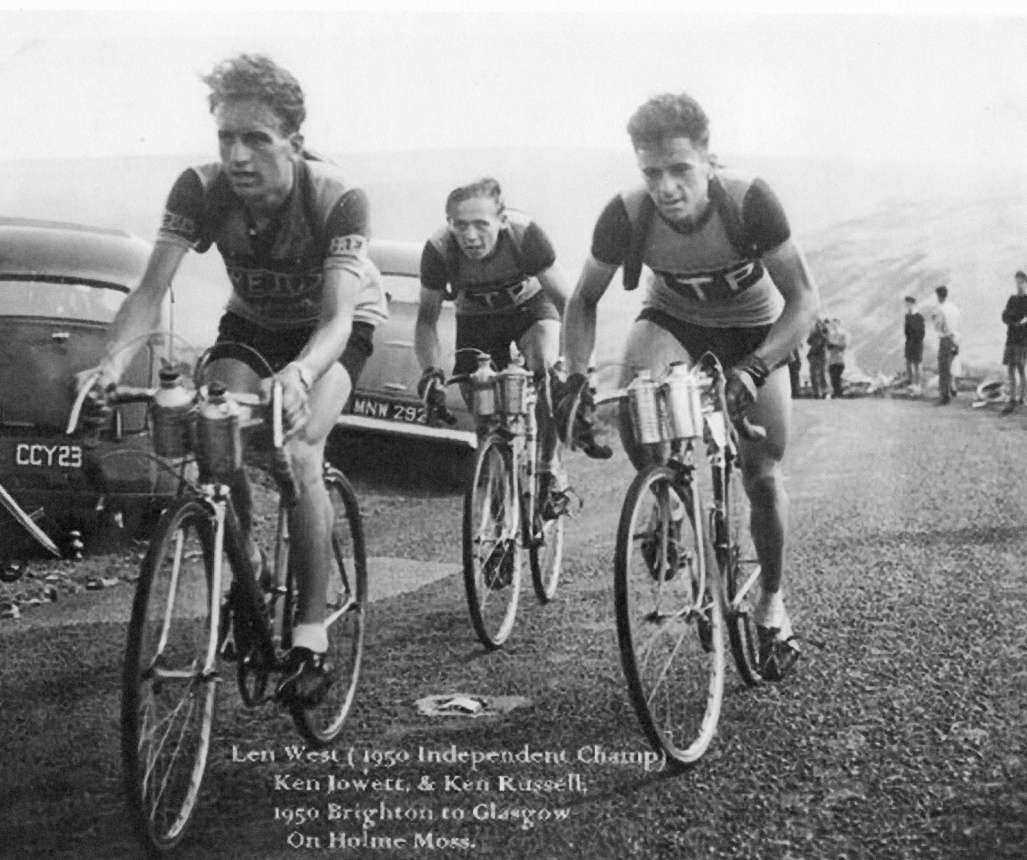
“I was interested to read the comments on mix and match brakes, particularly Mafac centre pulls, as I have used these brakes almost exclusively since 1958, and I am their No.1 fan.
From the 1950s to 1980s I was a member of the San Fairy Ann CC and Southborough Wheelers in Kent and, it is true, the side pull brakes available in the 50s and 60s were poor stoppers , especially in the wet. The Mafac Racer cured all this and were advertised in Ron Kitching’s 1959 Everything Cycling as requiring only “One finger sufficient!” to stop. Although Ron was prone to exaggeration, I think he was probably right in this case. Apart from the equal pull of the two arms, and the excellent studded brake blocks, their great advantage was the huge vertical adjustment of the brake shoes, up to 20mm, or ¾”, enhanced by brake shoe studs which allowed further angled adjustment up or down.
Mafac Racers will fit almost any lightweight, where other brakes fail, and they are working effectively on bikes as diverse as my 1950 Holdsworth with 26” wheels to my 1980 Carlton Clubman, which has very gappy clearances with 700c rims.
The one big disadvantage of Mafacs were their lever hoods, half rubbers in various colours, which were uncomfortable unless one wrapped vast quantities of cloth tape around them. The mix and match solution in many Kent and South London clubs was to substitute the excellent all black full rubber Universal brake hoods. These had the added advantages of a chunky, effective cable adjuster built into the metal body, rather than in the rubber hood on the Mafac, and very comfortable inside edges to the levers, kind on the fingers! These parts could all be purchased from George Reed’s discount cycle shop in South London. George was quite a character, nearly blind, and identified the bike parts by feel. Mafac levers were improved in the 1970s when they introduced their drilled levers with black all round hoods, thereby curing the problem.
The other disadvantage of the Mafac centre-pull was the very spongy centre pull hanger fitted to the headset, only remedied when Weinmann introduced their centre pull brake with the very solid brake hanger. I have Pivo and G.B. stems drilled to take a centre-pull cable, but I was not a fan of these, as they also gave spongy braking.
I also have a pair of later Mafac centre pulls with orthodox brake shoe fittings, i.e. parallel to the rims instead of at right angles, which I assume was a cheaper sports version.
The original front brake I bought as a schoolboy in 1958 for my Holdsworth Hurricane has been fitted to many frames and now used as the front brake of my Carlton and therefore serving 57 years, with no signs of wear yet. I have used modern side pull balanced brakes and have to agree that they have no advantages over my trusted Mafacs! “
Peter Russell reminisces:
I thought I would spend some reminiscing time today, going back to my cycle racing days, and appreciated you have been responsible for compiling a wonderful sequence of photos and pages of information regarding the sport/activity I knew so well. I would like to share them with you:
As a youth I was schooled in Eltham and I became interested in cycles around 1953 when I was given a rather splendid Raleigh Clubman of 1938 vintage by an uncle who had just come back from Burma. It was my Christmas present and was silver blue with all chrome forks, fixed wheel and very swoopy drop bars, and Brooks saddle of minimum proportions. Oh, and a single front brake.
I rode that bike a lot, and was bitten by the bug of racing. Initially against boys in the neighbourhood, once around the block. Unfortunately, the out of shape chainwheel wore a hole in the frame, so it collapsed under my increasing muscular development.
I now scanned pages of local papers, and found a man selling up his cycling paraphernalia, so with Dad paying, I parted with £5 to buy my first super bike. It came with helmet, racing vest and shorts.
t was a Chas Ryan! Never seen that name in any cycle-related journal. This cycle was all chrome, made for track use, with almost straight forks, short wheelbase, inch pitch block chain and wheel to match by Chater Lee. The bars were very wide drops in a swan-neck stem, all in steel. There was a single front brake of unknown origin . Saddle was the very narrowest Brooks you can imagine, and hard as a rock (Sprinter, I guess – Ed). I loved that cycle, and used it every day, including the paper round. I joined the Eltham Paragon as a junior and rode out on Sunday runs into Kent, happy days indeed. Unfortunately, my searching for speed caused me to run into the back of a parked car coming home from paper round and was not looking and well low over the ‘bars. This resulted in a bent frame needing straightening. I used it for many rides with the Club, even with 72 inch fixed wheel, climbing many hills which others couldn’t.
When I went to work in town, had some thoughts of new cycle, so was a regular visitor to Youngs Cycles in Lee Green. I really wanted a Frejus but they were too costly. Eventually I saved enough to buy one of the very first Youngs, in gunmetal grey, with Simplex rear mechanism and GB brakes. I was now taller and powerfully built, so ventured into time trials and didn’t do bad for 16 year old. That was my cycle until National Service called, so I joined the Navy and took the bike with me. I became a member of small racing team on HMS Ark Royal, beating the RAF team on Malta, anda few local races in Scotland. Managed to get some riding in Norfolk, Virginia as well when we berthed there.
When my service time was up I joined the London Fire Brigade and had enough money to buy another bike or two. I tried my hand with Herne Hill on a Youngs one-off track bike, in white. It was interesting but my fire-service duties got in way of regular meets there.
Also bought another road bike from Youngs. This was all singing and dancing, with metallic blue paint, three quarter chrome stays and forks, headstock in red, full Campag set of gears, Mafac brakes with Bartalli levers, and of course, Brooks saddle. Using this, I raced in time trials and road races at Brands Hatch. I had mediocre results really because, although fit, duties interfered with training.
In the Eltham Paragon, we had a mature man who started his own bike shop in Blackfen (SE London) and was making frames under his own name. Ted Mason was his name, badged as ECM.
I decided to have one of his. With gross extravagance, I ordered one in duck egg blue, red headstock (again) and three quarter chrome forks and stays. Equipped with latest Campag, TA cotterless alloy chainset, Mafacs with Bartalli levers again, Mavic sprint rims with large hubs, and quick release Campags for wheels. Plus the inevitable Brooks.
It became one of the most admired bike at the meets and rides out, and my times got a lot better over 10, 25, 50, 100-mile and 12-hours time trials. Now I was in my prime but I got married, so it all came to a halt, with kids and mortgage in the way. Bikes sold.
And here I am hankering after those days, knowing it cannot be as my 77 years and COPD tell me too late. But hope you enjoy my story, and now you have heard about Chas Ryan and ECM bicycles.
I wanted to give you details of my old Harry Quinn road bike that I have recently restored.
I purchased this frame direct from Harry Quinn in Liverpool in the very late 70’s and I recall being advised that it used to be the weapon of choice for Phil Thomas who was the Pro road race champion in 1983.
I raced the wheels off this bike in the 80’s, crits and time trials mid week then road race on the Sunday. Week in, week out and it was the training machine off season too. So one day cruising along nicely in the bunch the bike all went very peculiar with the feeling that I had punctured both tubs. I looked down and to my horror saw that the seat tube had become detached from the bottom bracket assembly. I was just swinging in the breeze and I very gently made it back to the race HQ.
At home I stripped the bike down and said I would send the frame off to the council dump next week. Well I never did chuck the frame away, it was nostalgia I suppose, I had had a few wins on the bike so it just sat in the corner of the garage gathering dust and homing spiders.
Now a few years forward and with the great increase in interest in machines of old plus my ever improving skills with the welding torch and spraygun I spied my old Harry Quinn and thought I should really do something about this old boy. Well, to condense about a month’s worth of work into a few sentences this is what I did. First off was getting the thing shot-blasted and boy was that seat tube ever rusty. I sliced the tube about an inch above the bottom bracket where the corrosion was bad then cut a section of thin wall tubing and having filed it so it sat on the bottom bracket without any gaps pulled the seat tube to one side, slipped the new bit of tube up into the seat tube and when everything was looking nice I brazed the whole lot up.
It took about two days of filing to get everything smooth enough for paint and I then got on with the other repairs the frame needed. I had crashed on the bike a few times and the top tube was comprehensively dented. Too much just for car type body filler so I had to lead fill the worst of the dents and thick applications of primer filler took care of the rest. At last I could get some paint on it and I chose a gun metal shade of base and clear, I believe it is a Ford colour, and Porsche India red panels. Decals came from Mr Lloyd and four coats of lacquer finished the job off. I always mix in lots of hardener so I can get on with the build up without too much delay.
The build up started with some unknown forks I took off a frame to replace with carbon ones but they fit and they are chrome. I’m a Campagnolo man, all my bikes are Campag, so the Quinn has Delta brakes, super record seat pin and Cinelli saddle. Fully polished Record 54/42 chainset, Nuovo Record rear mech with billet sealed bearing jockey wheels and Record front mech. Cinelli record stem and Cinelli 65 bars, my favourite, and the piece de resistance, 50th anniversary hubs on Mavic CD sprints. Oh Campag Record pedals and Christophe clips as well.
I am so so pleased I didn’t dispose of this frame as it rides beautifully, it’s really fast and I hope you agree, looks great.
You wondered on your lovely website what blocking might be. It was also known by the less lovely name of butchering.
If it was done correctly, the leather was un-riveted from the back of the saddle, which as your site rightly says tended to be square and flat in those days. The cantle was put in a vice and then squeezed, to make it rounder and make the saddle narrower. That also had the effect of making the saddle snugger to ride, because it nestled into your bum better.
Rounding the cantle meant that the holes in the leather no longer quite matched those in the cantle. They weren’t far out but they still couldn’t be used. Instead, the holes had to be widened to make a match. That in turn meant that the original narrow rivets wouldn’t fit because they’d go right through the widened hole.
The technique was to use a copper rivet with a wide head. That could be hammered still wider until it covered the original hole and its extension.
In those years, riders yearned to have saddles of the sort they saw on the bikes of continental pros. Not only did they have big, and obviously big, rivets but they were also shallower and more rounded, the sides rolling in beneath the sitting area.
That was the butchering. Once the saddle had been fitted to the modified cantle, the leather was subjected to whatever fancy potion the tradesman doing the job swore was best. It may be soaked in oil, even wine. It was often hammered to make it more supple. The surplus leather was cut off, exposing the nose, removing bits that stuck over the back of the cantle and often trimming the saddle lengthways along its edges.
It would then be bound with tape to give the saddle what was sometimes called a dried-kipper look, as near to tube-like as a saddle can be. And then it was handed back, with a price ticket, and a rider kept it and rode it for the rest of his life.
It took declining sales in the face of newer plastic saddles to push Brooks, then a conservative organisation, into reacting. The result was the Brooks Professional saddle, better leather (I’m told), a hopeless attempt at mimicking the shape of the continental butchered saddles, and with cosmetic, wider rivets that had no function beyond copying what on the pros’ saddles was a necessity.
And then artificial saddles took over and the old traditions and envies were blown away along with wool jerseys and soggy bike shoes. I hope that helps. You should be able to find pictures of continental butchered saddles without problem.
For sale:
David Rutter from Brighton has for sale the following:
LES RIGDEN SPECIAL (built for David Rutter circa 1980) 22″light blue frame, pale blue forks and tops of seat stays, decorative lugwork
(built for David Rutter circa 1980 partly as a “thank you” for assisting Les to set up his stable workshop)
CINELLI-bars and stem
DIA-COMPE-brakes
SULKY-brake levers
SUNTOUR-handlebar gear changers
IDEAL-saddle (better than Brooks I think)
CAMPAGNOLO-seat stem
CAMPAGNOLO RECORD LARGE FLANGE-hubs
MAVIC G40-rims
SUNTOUR ARX-derallier
CAMPAGNOLO RECORD -twin chainset and cranks
STRONGLITE SPIDEL-headset
CAMPAGNOLO-bottom bracket
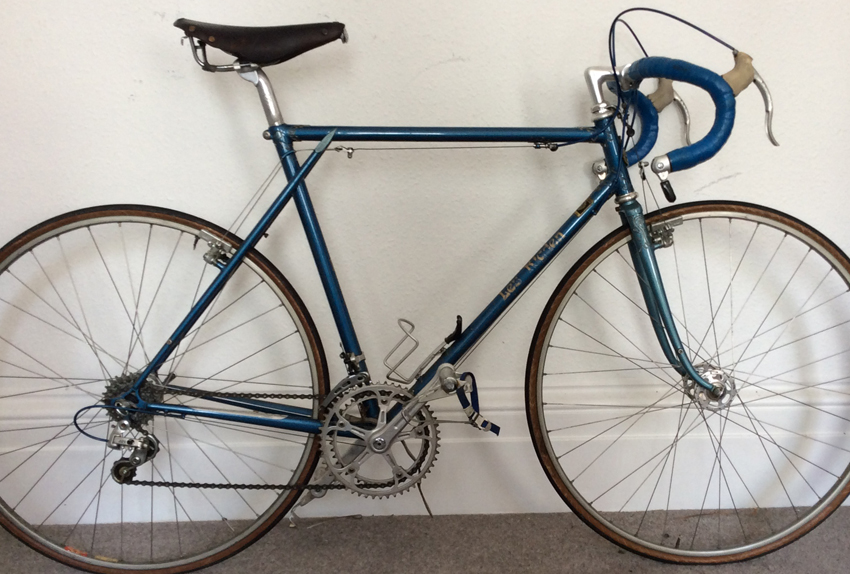
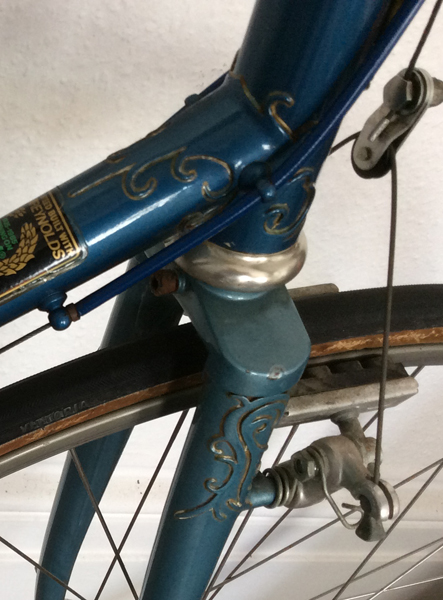
I would be warmly grateful for any help you can give me to ensure the Les Rigden Special built by Les in Brighton, where he was a cult figure in the cycle trade, finds a good home. More images available. Contact David Rutter, tel: 01273 605355 or email at lizanddavid(at)msn.com
The Golden Age of Cycling Exhibition and Ride
This free exhibition of Classic Lightweight bicycles from the period 1930 to 1970 will be held on Sunday, September 27th at: Oakhill College in Whalley, Lancashire BB7 9AF.
The owners of bicycles dating from the ‘Golden Age’ (or thereabouts) are invited to display their machines in the College’s Millennium Hall between 10am and 2pm. The exhibition will be followed by a short, one hour ride in the Ribble Valley on a route most suitable for those choosing to ride with fixed wheel.
Exhibitors are asked to bring along their own bicycle stand and a short description of their machine/machines any time after 9am. The College has a large free car park and refreshments will be available. Admission to non-exhibitors will be by voluntary donation to the school’s Duke of Edinburgh Award Scheme.
If you intend to exhibit one bicycle or more it would be helpful, though not essential, if you would let Charles Jepson know in advance.
Posted: Saturday 15th August 2020
Contents
- Introduction
- Photograph
- Cycle Style
- Derek Browne In Response
- Great Britain International Riders
- Rebels
- Mike Baker In Response
- Front Brake
- Peter Russell
- Youngs Cycle
- Eltham Paragon
- Duck Egg Blue
- Graham Kerr
- Leo Woodland
- For Sale
- Les Rigden Special
- Les Rigden Special Built
- Cycling Exhibition And Ride
- Free Exhibition
This article appears in the following categories.
Upcoming Events
Whether you are looking for a gentle social meet up, or a 100-mile ride browse the community’s upcoming events and plan your next weekend outing.

